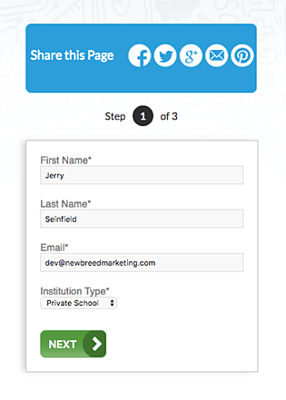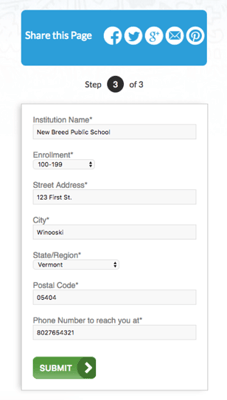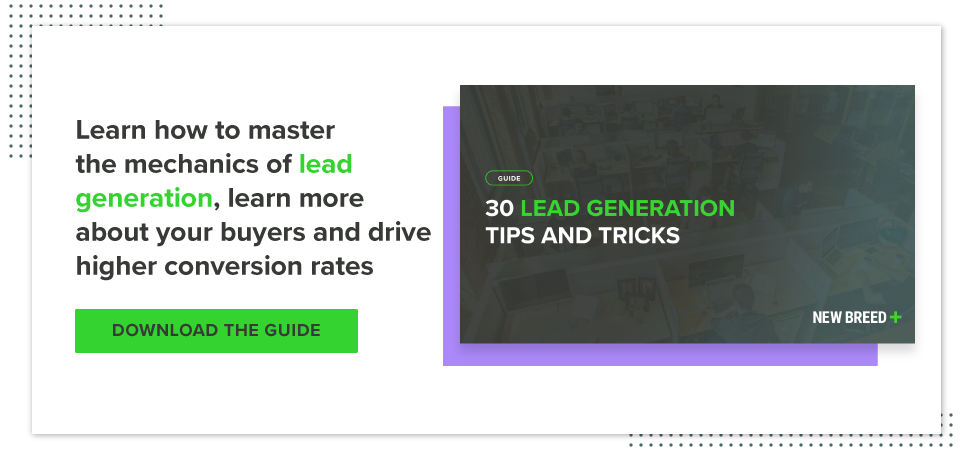Form Strategy: Balancing Need for Information with User Experience
.png?width=1200&name=Q4%20Blog%20Images%20(61).png)
Form strategy is all about give and take. Prospects want personalized, contextual communications, but they also want to maintain their privacy. Businesses need to collect information about prospects in order to provide personalized experiences, but they don’t want to make it difficult for prospects to convert.
To solve for the needs of both companies and their site visitors, web strategists and operations strategists need to balance information gathering with user experience (UX) to create the most effective form strategy.
“When I think about forms from a UX perspective, I want them to be as straightforward and to the point as possible. I want there to be the least amount of friction for the user to submit their information on the form, and then I want to make sure you don’t scare someone away from your page from seeing a giant form,” says Senior Web Strategist Adam Kinsella.
“From the operations perspective, what you want to have is enough information to do stuff like segment [the user] down to the correct persona. You want to be able to send them over to the right sales rep at the appropriate time — which means you need to have a lot of information from them, like what their company size is, what their annual revenue is, what industry they’re in, what their biggest pain point and challenge is,” says Head of Demand Generation Guido Bartolacci.
You don’t want to ask too much of a prospect too early in your relationship, but you need to gather enough information to continue the conversation with them.
“If you just have someone’s email, do you think it’s possible to send them relevant enough information to keep them engaged to get them to make that next conversion where they’ll provide more information?” Guido asks.
Adding a purposeful question that can help you recommend resources to engage with a visitor will contribute more value without asking too much.
“I don’t think you run the risk of creating a ton of friction if you’re adding one or two extra questions,” Adam says. “The problem is when someone sees your form and doesn’t see where it actually ends on the page and scrolls down to see they have to fill out 20 fields to get the e-book they want.”
Align What You’re Asking for with the Value You’re Providing
The key to collecting the information you need without making visitors feel apprehensive is to match what you’re asking for with the offer you’re providing in exchange for filling out the form.
Say you have an anonymous visitor come to your website and immediately click a CTA to book a meeting with your sales team. In order to make sure they can gain value from that meeting, you need a lot of qualifying information.
“That’s a case where I think [the number of questions] matches what the return from filling out this form is,” Adam says. “If you’re clear that you need all that information so you can put together the best possible recommendation for the user, that’s where I think it does make sense to have, within reason, a decent number of form options.”
However, asking the same number of questions for an e-book download isn’t appropriate.
For bottom-of-the-funnel (BoFu) offers that result in hyper-personalized information or a meeting with a person, you can ask for in-depth details. However, for a top-of-the-funnel (ToFu) download, like a high-level e-book, Adam recommends asking no more than six form questions, with name, email, company and website URL counting toward those six.
“Six is the max where we can still make that look like a pretty short form,” Adam says. “Whereas some BoFu forms can go 12 to 20 fields.”
When considering how much friction your form is posing, you need to take into account not just how many questions you’re asking, but also what type of information you’re asking for.
For example, annual revenue is numerically a smaller ask than first and last name, but it poses more friction.
Reduce Friction with Your Form Design
“Make sure that you don’t make the user think about how they’re going to fill out the form. Make it as straightforward and intuitive as possible,” Adam says.
How a form is designed and styled can make it a more engaging experience for visitors. For example, a streamlined one-column form creates a better experience than a crowded three-column form.
Additionally, features like dependent fields can enable you to ask follow-ups based on responses so you request information from the specific audiences you need it from as opposed to everyone filling out the form.
[gif of our contact us form]
For example, on New Breed’s Contact Us page, the response to “What can we help you with?” determines what other fields a visitor needs to submit. If someone is looking to become a client, they’re asked all the questions our sales team needs to know in order to follow up. However, if someone wants to submit to our blog, they’re only asked to tell us more about their pitch.
This enables us to collect relevant information from specific segments of our audience without posing too much friction for other users.
Multi-step forms
Multi-step forms are another way to design a form with many fields in a user-friendly way.
Multi-step forms break your questions up into smaller groups. If you’ve ever placed an order online you’ve probably filled out one where you’ve first confirmed your order, then filled out your shipping information on a second page and provided payment and billing information on a third page.
Breaking a form into sections makes it more consumable for users and lessens the likelihood they’ll be overwhelmed by how much is being asked. The downside is that users can’t immediately tell how much the form is asking for.
To solve for that, Adam likes to start multi-step forms with the hardest questions or questions that have long drop-down menus. Then, the next page would include fill-in-the-blank or checkbox questions. Finally, the last page would ask for basic contact info.
Quizzes
Turning a form into a lead gen quiz is a great way to collect more intimate information about a person without them feeling like you’re asking for too much.
The trick is to tie the quiz to information people want. For example, if you can use qualifying questions to create personalized insights, you can both collect information and provide a valuable resource.
For these quizzes to work, you should include the value proposition in the lead-in copy so users are compelled to complete all the questions. Additionally, you need actually to follow through on the value prop that you introduce the quiz with.
Natural Language Form
Another option for making your form more engaging is to style it as a fill in the blanks paragraph, like a mad lib, as shown above.
These can be fun to fill out, creating a novel experience, but are only effective when you only have a couple of fields to request. Asking too many questions in a natural language form will present users with a wall of text.
Collect Information Without Forms
Forms aren’t the only way to gather data about your site visitors. Using alternative methods like conversational marketing and lead enrichment tools can reduce friction or even eliminate it entirely.
Reducing friction is one of the main goals of conversational marketing tools like chatbots. They enable visitors to provide information about themselves and request information from your company in real-time, unlike forms.
Lead enrichment is not an alternative to forms, but rather a way to make your forms easier to fill out.
Using sales intelligence tools, you can collect specific pieces of identifying information and the tool will backfill all the other details. For example, you can ask for just a company URL on a form and still receive company size, industry, location, etc.
This prevents you from requiring leads to keep filling out additional forms to gather more information or from needing team members to do this research and update contacts manually.
“With enrichment tools, you can focus on the types of questions and the information you want to gather that you can’t get elsewhere,” Guido says.
What a contact’s biggest challenge or area of expertise is, for example, is something you can only learn by asking them.
The Takeaway
“All of this boils down to treat a form how you would actually talk to a person,” Adam says.
Don’t get too personal too soon and don’t ask for more than what you’re providing in return.
“I think that when we say ‘this form is creating friction’ we’re saying ‘the intent behind this form is causing friction’ — unless it’s a horribly styled form,” Adam says.
If in doubt about a user’s willingness to answer all of the questions you want to ask in exchange for a given offer, err on the side of asking less.
“Weigh getting any information from someone versus getting no information from someone when you’re considering how long the form is going to be relative to the perceived value of that content,” Adam says.
While you’re balancing the size of your ask with what you’re offering, keep in mind the long-term value of how the information you’re collecting for your continued communications.
“You shouldn’t be afraid to ask for certain things from a visitor. You’re building an experience for them to add value to their day-to-day,” Guido says. “If you do that well enough, you have every right to ask for certain things, so don’t let fear of friction or a poor user experience scare you off from asking something that would enable you to create a better experience for the person long-term.”
Quinn Kanner
Quinn is a writer and copyeditor whose work ranges from journalism to travel writing to inbound marketing content.




.png?width=246&name=unnamed%20(53).png)

.png?width=853&name=unnamed%20(54).png)
.png?width=865&name=unnamed%20(55).png)


